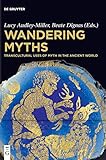Wandering Myths : Transcultural Uses of Myth in the Ancient World / ed. by Beate Dignas, Lucy Gaynor Audley-Miller.
Material type: TextPublisher: Berlin ; Boston : De Gruyter, [2018]Copyright date: ©2018Description: 1 online resource (LIV, 427 p.)Content type:
TextPublisher: Berlin ; Boston : De Gruyter, [2018]Copyright date: ©2018Description: 1 online resource (LIV, 427 p.)Content type: - 9783110416855
- 9783110421514
- 9783110421453
- 292.1/3 23
- BL785 .W36 2018
- online - DeGruyter
- Issued also in print.
| Item type | Current library | Call number | URL | Status | Notes | Barcode | |
|---|---|---|---|---|---|---|---|
 eBook
eBook
|
Biblioteca "Angelicum" Pont. Univ. S.Tommaso d'Aquino Nuvola online | online - DeGruyter (Browse shelf(Opens below)) | Online access | Not for loan (Accesso limitato) | Accesso per gli utenti autorizzati / Access for authorized users | (dgr)9783110421453 |
Frontmatter -- Contents -- Preface. Wandering Myths: Transcultural Uses of Myth in the Ancient World -- Introduction. Travelling Myths, Travelling Heroes -- Part I: Changing Cultural and Mythical Landscapes in Anatolia -- Kingship in Heaven in Anatolia, Syria and Greece. Patterns of Convergence and Divergence -- Making Meaning of Myth. On the Interpretation of Mythological Imagery in the Polyxena Sarcophagus and the Kızılbel Tomb and the History of Achaemenid Asia Minor -- Myth, Memory and the Past. Wandering Heroes between Arcadia and Cyprus -- Part II: Reception and Innovation of Mythological Programmes between Greece and Italy -- From Mezntie to Mezentius? The Stratigraphy of a Myth in Etruria and Rome -- Pots, Plots, and Performance. Comic and Tragic Iconography in Apulian Vase Painting -- Distributed Narrative. A Very Short History of Juxtaposing Myths on Pompeian Walls -- No One is Immortal. From Exemplum Mortalitatis to Exemplum Virtutis -- Attic Sarcophagi. Myth Selection and the Heroising Tradition -- Part III: Wandering East, Wandering South -- Gilgāmeš and Homer: The Missing Link? -- Myth, Memory, and Mimesis. The Inaros Cycle as Literature of Resistance -- Death on the Nile: The Myth of Osiris and the Utility of History in Diodorus. Egypt In Greco-Roman Historiography -- Wandering Hero, Wandering Myths? The Image of Heracles in Iran -- The Transformations of Achilles on Late Roman Mosaics in the East -- Epilogue -- Index
restricted access online access with authorization star
http://purl.org/coar/access_right/c_16ec
In spite of the growing amount of important new work being carried out on uses of myth in particular ancient contexts, their appeal and reception beyond the framework of one culture have rarely been the primary object of enquiry in contemporary debate. Highlighting the fact that ancient societies were linked by their shared use of mythological narratives, Wandering Myths aims to advance our understanding of the mechanisms by which such tales were disseminated cross-culturally and to investigate how they gained local resonances. In order to assess both wider geographic circulations and to explore specific local features and interpretations, a regional approach is adopted, with a particular focus on Anatolia, the Near East and Italy. Contributions are drawn from a range of disciplines, and cross a wide chronological span, but all are interlinked by their engagement with questions focusing on the factors that guided the processes of reception and steered the facets of local interpretation. The Preface and Epilogue evaluate the material in a synoptic way and frame the challenging questions and views expressed in the Introduction.
Issued also in print.
Mode of access: Internet via World Wide Web.
In English.
Description based on online resource; title from PDF title page (publisher's Web site, viewed 04. Okt 2022)


